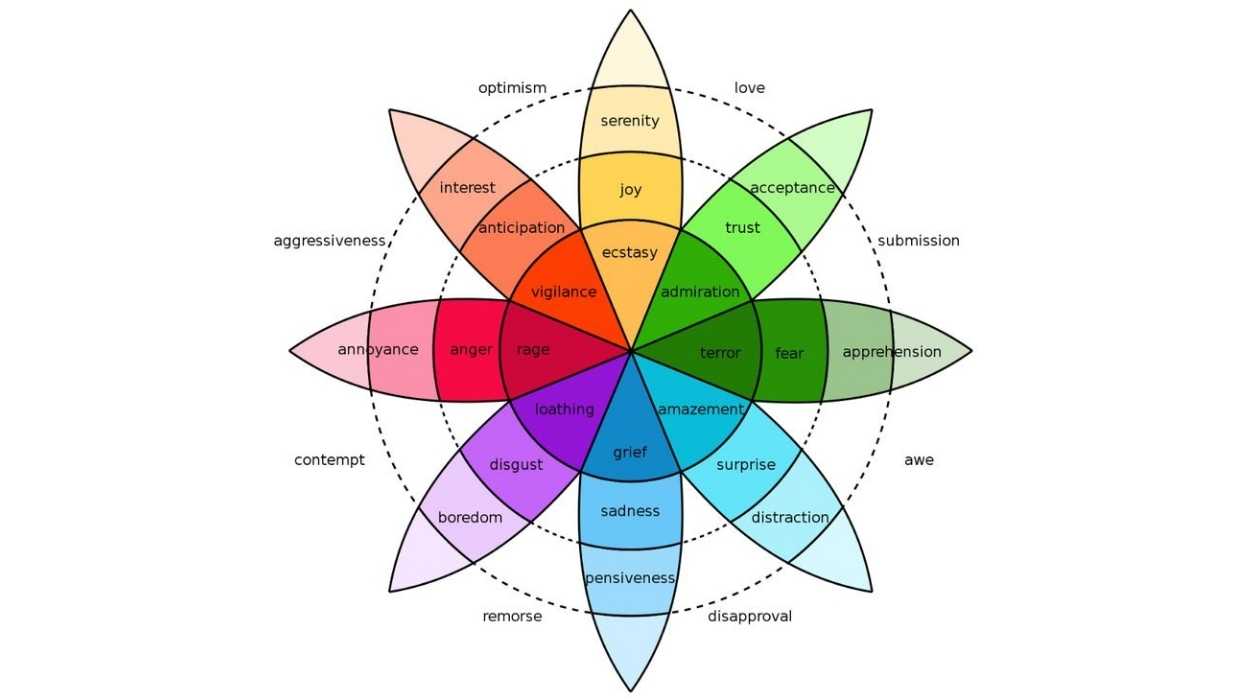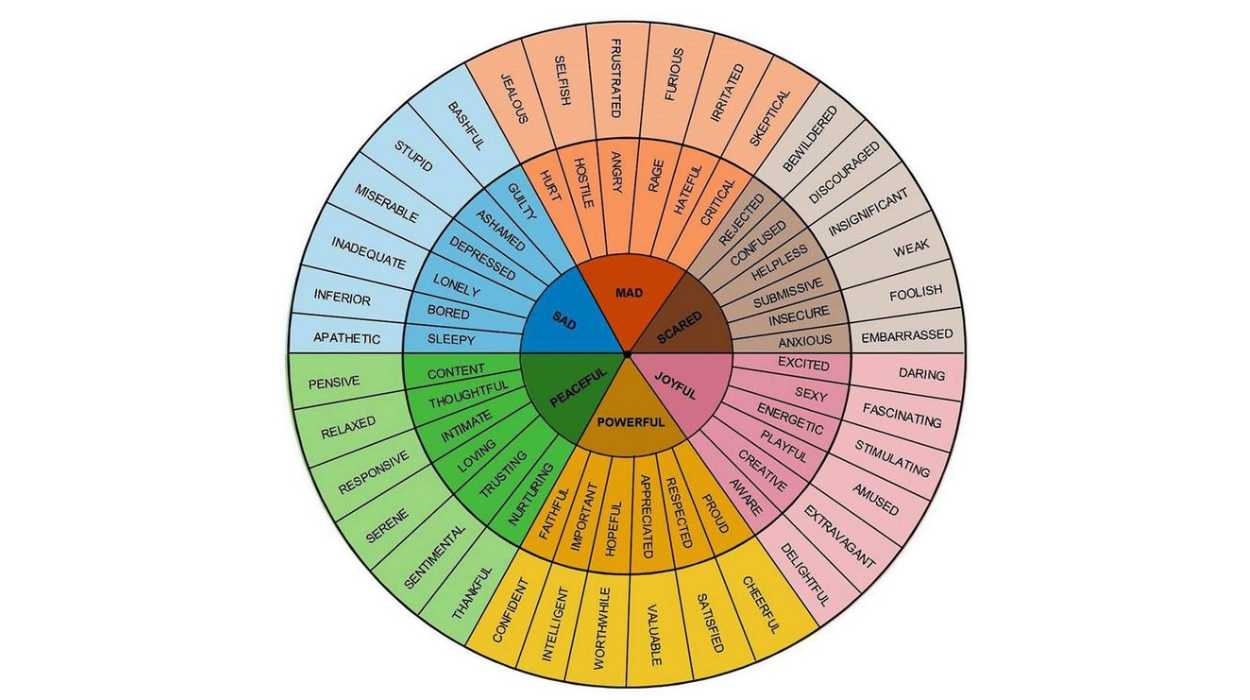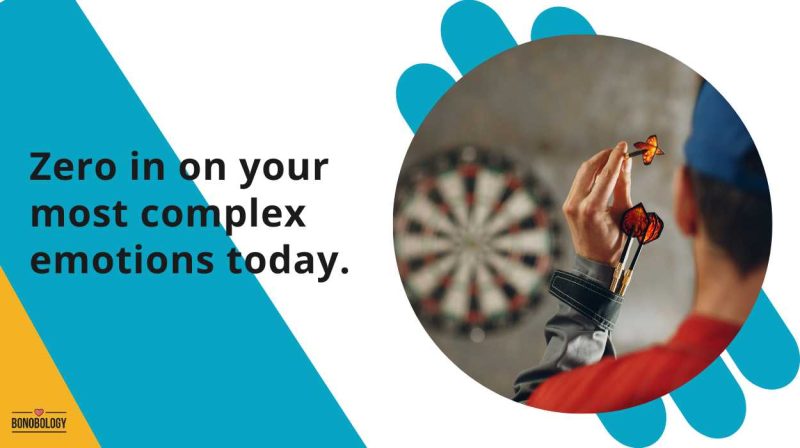You might think, “Everyone has emotions. Don’t we know this stuff already?” Incredibly, we don’t. We are the products of ‘suck it up’ culture after all. This is why Robert Plutchik came up with the emotion wheel in order to make complex emotional experiences more accessible for us and to help us deal with the toughest circumstances and feelings, especially during relationship rough patches. With this tool, you can slowly become aware of your emotions much beyond “I’m not feeling okay” when trying to communicate your feelings to your partner, or in the middle of a conflict.
Humans experience a range of emotions and physical sensations, but we learn to dismiss them from an early age. Research clearly states that “emotional suppression gets held in the body and creates a host of downstream effects, including anxiety, depression, stress-related illness, all the way to substance abuse and suicide … Suppression doesn’t make the emotion go away, it just stays inside you causing more pain.”
Understanding how the emotion/relationship wheel works will help you in not just being self-aware but also in building a more intentional and empathetic bond with your partner, even during disagreements. Emotional literacy might just be one of the best tools for an internal as well as a political transformation — We’ll explain how.
What Is The Emotion Wheel?
Table of Contents
The above research says that “emotional intelligence (EQ) is a key predictor of mental health. Our EQ refers to our ability to be aware of, regulate, and express our emotions and to understand, and respond skillfully, to the emotions of others.” Imagine how crucial this skill is in romantic relationships where emotions run high, but so do misunderstandings. Luckily, emotional attunement with your partner can be learned.
Robert Plutchik’s wheel of emotions is a visual tool of EQ that helps you identify the nuances of primary and secondary emotions which you’re experiencing at any given moment. This mood wheel, as shown below, showcases eight primary emotions:
- Anger
- Anticipation
- Joy
- Trust
- Fear
- Surprise
- Sadness
- Disgust

Polar opposite emotions like joy and sadness or fear and anger are placed diagonally in this visual relationship wheel. Like primary colors, these emotions can mix and match with others in order to create more complex emotions like acceptance, annoyance, boredom, etc. With the use of this tool, you and your partner can tell each other ‘exactly’ what you’re feeling. This way, no one feels misunderstood, and you both learn how to support each other better.
Related Reading: 10 Critical Emotional Needs In A Relationship
Different types of emotion wheels
Besides Plutchik’s wheel that gives you a primary and secondary emotions chart, you both can learn how to use emotion wheels created by other experts too. You might need them in case you find this one inadequate. Or you may want to use more than one in your pursuit of every human emotion that your loving relationship can entail. Here they are:
- Geoffrey Robert’s Feel Wheel: It’s a variation of the Plutchik’s wheel and expands eight basic emotions to 130. It mostly focuses on negative emotions
- Geneva Emotion Wheel: It is an emotion and feeling wheel to measure different types of human reactions to objects, events, and situations. It includes “no emotions” or “other emotions” which is helpful for those who experience numbness or alexithymia
- Junto Emotion Wheel: Love is a basic emotion in this one. If you see this emotional wheel chart, you’ll notice 108 emotions in this dictionary of feelings
Also, people confuse the emotion and feeling wheel, as both are designed to help us know our feelings and be patient in a relationship. Let’s clarify the difference between the Gottman feeling wheel, also called the feeling wheel by Dr. Gloria Wilcox, versus the emotion wheel by Robert Plutchik.
| Gloria Willcox feeling wheel | Plutchik’s emotion wheel |
| Six primary feelings: mad, sad, scared, joyful, powerful, peaceful | Eight primary emotions: anger, anticipation, joy, trust, fear, surprise, sadness, disgust |
| How to use the feeling wheel: Core emotions are in the middle wheel, which then branch out to the outer edges with secondary emotions and tertiary emotions | How to use the emotion wheel: Core emotions are in the middle wheel, intense feelings in the innermost one, milder emotions in the outer one. It’s a visual aid for polar opposite emotions as well |
| This wheel helps people identify their specific feelings and deal with them with more agency | The emotion color wheel portrays emotion as a survival-oriented behavior as well as a tool to identify the nuances of our emotional experience |

Why is it important to learn about emotions?
Our emotions are a survival mechanism. They tell us what we need to address. The uncomfortable feelings that you experience during a relationship are sometimes normal, and a map to the places that need healing. Ignoring them or not understanding your partner’s emotions can create huge rifts between you two.
After all, suppression of mild to intense feelings is a health crisis. And we need to talk about that before we learn how to use the emotion wheel psychology by Plutchik. You might have a partner who has trouble identifying how they feel, or maybe you are struggling with the same. You wonder, “My partner won’t talk to me. Why do they suppress their emotions deliberately?” Here are some possible reasons:
- Your partner may have alexithymia: It is when a person finds it hard to experience or identify feelings, and has difficulty expressing emotions too. It can be due to trauma, mental health issues, or autism
- Others first: Your partner may have been used to prioritizing other people’s emotions because of a tough childhood or because they are constantly in situations where they are overburdened with emotional labor
- The dominant groups misunderstand/penalize them: Black people are always asked to be less angry for no reason other than racism (especially when they talk about their rights). The neutral face or tone and body postures of many autistic people are judged to be arrogant, abnormal, less empathetic and intelligent – so we mask a lot. There are also cultural differences in expression of emotions; here, the dominant/oppressor culture gets to decide what’s appropriate
- Your partner’s emotions are disbelieved: Do the people around them often disbelieve your partner’s discomfort? Have they been told that their feelings aren’t real by their family/loved ones?
- They fell for the ‘Laziness Lie’: Social psychologist Devon Price says in his book, Laziness Does Not Exist, that we inaccurately think we’re not doing enough. Also, “We are made to believe we cannot trust our own feelings of exhaustion or sickness, and that none of our limitations are acceptable.”
- They are affected by toxic positivity: No one can stand the ‘be happy, don’t cry’ tribe. They might be responsible for most of the global emotional repression
- “I got over it, so should you”: Even more frustrating are those who think that everyone’s anxiety, stress, depression, trauma, etc. should work within the same timelines as their own. Your partner may have internalized the ableism shown by someone they care about
- Male conditioning: Men are taught to gender emotions. Since some emotions are taboo for them to feel, express, and relate to, they feel alone/upset/ashamed when those feelings crop up
With this backdrop of emotional repression, do you see why emotional intelligence is crucial for romantic intimacy and an overall cultural reboot? Plutchik’s model of mood wheel is the first step toward understanding your feelings and those of your lover.
Related Reading: Emotional Intelligence In Relationships: Make Love Last Forever
8 Benefits Of Plutchik’s Emotion Wheel
Emotions are not just feelings, they take our bodies into account too. They consist of 5 components:
- Emotion component, where you feel the feeling (disappointment)
- Action tendency component where your body has the urge to react to the feeling (wanting to get away from the person/situation)
- Appraisal component, where you understand the cause of the emotion (you were expecting your date to be nice to the restaurant staff but they were rude to the servers)
- Motor component, where you express emotion through hands/face/movements, etc. (you shake your head slightly, your pained facial expressions, etc.)
- Physiological component, where your body goes through a chemical reaction because of the emotion (your throat constricts)
If people know what’s going on inside them, they can advocate for their needs better. This helps further the affection and intimacy in a relationship, heal dynamics at work, create room for healthier relationships with friends and family, and build a compassionate sense of community. Here are some relationship benefits of using the primary and secondary emotions chart of Plutchik’s wheel of emotions.
1. Emotion color wheel leads to more self-awareness, which leads to more intimacy
When people get in touch with themselves, they are more in touch with others. Lindsay C. Gibson, author of Adult Children of Emotionally Immature Parents: How to Heal from Distant, Rejecting, or Self-Involved Parents says, “Covering up your deepest needs prevents genuine connection with others.” For a truly romantic connection with a partner, you’ll need to get to know yourself better too.
Brianna, a car dealer from Detroit, shares, “I thought knowing about emotions is enough to feel them and overcome them. Looking at a feelings list for adults isn’t enough, it needs a lot more work! Last year, a partner’s emotional needs went unfulfilled because I wasn’t attuned to them. That compelled me to look at a mood rings chart by Plutchik. Practicing it has been a huge step forward for me. Both of my partners understand that I’m still trying to understand my emotions and they are incredibly patient with me when I take time to process situations. It’s made me love them even more.”
Related Reading: Non-Monogamous Relationship: Meaning, Types, Benefits
2. You can learn how to make accommodations for everyone
A fellow autistic friend, who works at a place that calls itself ‘disability-inclusive’ everywhere, laughed when I asked them what accommodations they get for their disability, “There are none. Though it’s legally required, the topic is swiftly dismissed if I bring it up. But I get it, they can’t accommodate my disability needs, or the emotions that come up when those needs are not met consistently.” Why not, I asked. They said, “Neurotypicals don’t even accommodate their own needs and emotions! Forget workplaces, have you seen how we all make ourselves smaller in relationships too?”
An accommodation request for disabled people is certainly met with eye rolls, and claims of being lazy or asking for special privileges – Whether in platonic or romantic relationships. However, my friend is right, the situation is bad for non-disabled people too. The writer of Laziness Does Not Exist says: “When a person believes that the only way to be loved is to please somebody else, they end up in all kinds of overly demanding relationships, forever giving more than they receive and never feeling truly seen.” Emotional accommodation is the first sign of self-compassion.
3. Emotion wheel helps you feel your feelings to resolve relationship conflicts
As annoying as it gets to hear from social media and our own therapists to ‘feel your feelings’, validating your basic emotions a) eventually heals trauma slowly, b) allows us to ease daily stress, c) resolves relationship conflicts without letting them drag on for days, weeks, and years. If you and your other half spend time with the unpleasant feelings (not analyzing them), it’ll help you both let go of them – if done gently and consistently in a safe space.
4. It’s great for overall health and a sense of agency in relationships
Emotions affect our bodies and their working, so you and your partner can have better overall health through the practice of emotional intelligence. It’ll help you recognize your discomforts, have a better understanding of boundaries with each other, say ‘no’ or ‘yes,’ or slow down when needed.
You can also take space in a relationship when you want to rest for a bit; this will only help your bond in the long term. Devon Price, the author of Laziness Does Not Exist, says, “Great healing can be found in listening to our bodies and honoring our needs for rest and idleness. It’s revolutionary — and deeply healing — to listen to our bodies’ pain or exhaustion and respect it rather than judging it.”
5. Emotional vocabulary gives you freedom of expression
A study in the Journal of Abnormal Psychology found that suppression of behavioral responses to emotion had physical effects on the participants. The effects included elevated heart rates. This suggests that expressing behavioral responses to stimuli, both positive and negative (in a healthy way), is better for your overall health.
Do you feel like you need to suppress your emotional reactions around your partner a lot? If yes, this needs to be addressed through the emotion wheels a little urgently, for the sake of your intimacy and continued commitment.
6. A great reason to use the wheel: Controlling emotions so they don’t control you
People believe that the more they can control their emotions, the better they can control their lives. This form of control is mostly exerted by pushing their feelings down, which gets transformed into physical, mental, and emotional stress. We deal with this later in the form of burnout, health issues, or having relationships that are poorly suited, demanding, or toxic.
You can predict future events if you’re attuned to certain feelings and your evolving emotional states; which means you can prevent a negative reaction from taking place. For example, if you have anger issues, rage anticipation can help you curtail aggressive behavior toward your partner. It’s much more rewarding and empowering to listen to your body, I promise.
7. Survival of the most emotionally aware partner
What purpose do emotions serve? Historically, they’ve helped our species survive and be in sync with each other to anticipate, recognize, face, or get out of lethal trouble. But within the framework of relationships, they help us connect, relate to each other, nurture safety, empathize, and celebrate milestones together. Emotional awareness is a matter of continuity of our species.
Related Reading: Freedom In Relationships – What It Means And What It Doesn’t
8. Get that money!
You and your partner, if you’ve decided to live together, may want to go for jobs that celebrate your emotional awareness. Emotional literacy seems to be good for the career, according to Forbes. It’s highly correlated with stellar work performance. Emotionally literate leaders and managers are far more effective. It creates conditions for personal happiness – and happy workers are a great asset because they are more creative and productive.
How To Use The Emotions Wheel To Build Healthier Relationships
Let’s understand emotions first. Imagine this scenario: You are at a restaurant. Much like Jack Black’s character in The Holiday, you see your partner through the restaurant window, kissing someone outside. Now imagine these different types of behavioral reactions to the same stimulus:
- In the movie, his physical response was to jump up, go out, and confront her
- Another person might look for a few seconds and go calmly back to their meal and company
- Another person can feel all the consequences of the affair. Trembling, eyes wide, voice shaky, they might announce the news of infidelity to everyone on the table
- And yet another person might look at the unfolding scene, be surprised, and then feel relieved. Because they were cheating too or because they have been thinking about breaking up anyway
This was a collection of various emotions+behaviors. We all experience stimuli in a subjective way, but there are 3 components of emotion psychology that are mostly common to everyone:
- Mental reaction (e.g., anger, acceptance, fear, relief at being cheated on)
- Physiological reaction (effect on heart rate, respiration rate, facial electromyographic activities, etc.)
- Behavioral responses (eyes going wide, sighing, trembling, smiling)
Complex emotions in relationships
Download an emotion wheel PDF/chart by Plutchik. You’ll notice that it has intense versions of the 8 primary emotions in the innermost circle, the primary emotions in the middle, and their milder versions in the outer circle. For example, ecstasy (inner circle), joy (middle), serenity (outer). There is an outermost circle too that has combinations of emotions. For example, fear + surprise = awe.
An example of a complex emotion in your dating life: You pick up on the signs of chemistry on a first date and come back feeling great and smiling wide. If you have a look at the wheel, you might realize that you’re feeling ‘optimistic’ and not just ‘happy.’ This lets you listen to your body cues too, and now you know that you’re positively ‘anticipating’ the next date! This is how emotion translates to action.
Related Reading: Embracing Emotional Vulnerability: Encouraging Men To Express Their Feelings
Activity for emotional intelligence — How to use the wheel of emotions
You can put the emotion wheel into motion through various activities for emotional intelligence. Let’s try one. We’ll follow this couple, especially partner A, through their stages of conflict.
The event that leads to the conflict
A and B are spouses. B receives a call from their abusive ex. Just before they both leave for work, B tells this to A, and adds that it was nothing to worry about. A goes to work, but they feel restless throughout the day. They don’t understand what they are going through. Surprise? Suspicion? Disapproval? No. But they are feeling multiple emotions at once and it’s giving them a headache.
The conflict between A and B
They get back home and B can sense something is off. A’s unaddressed emotional state is creating friction between them. B thinks A is mad at them; B is hurt but gives them space. A feels guilty; they want to sort this out.
Related Reading: 13 Signs He Regrets Hurting You
Use of emotion wheel in a relationship conflict
Person A realizes they need to dig out the feelings list for adults that they’ve referred to before. This is where the emotion wheel comes in. Here’s how it goes:
- A kinda knows they are angry, so that one’s easier to point out
- They look at more emotions and see ‘disgust.’ The way their body resonates with that word makes them sure they are feeling that as well
- They suddenly realize that they have been angry toward B’s ex, not B or anyone else. Naming the exact emotion (disgust) helped with that; ‘angry’ was too general and didn’t capture their feeling accurately
- They spend more time with the Plutchik model, and guess which two basic emotions combine to create the emotion of contempt? Anger and disgust. “Makes sense that I’m having this emotional response for someone I hate and disrespect,” A thinks. They dig deeper
- More emotions crop up. They are also feeling vigilant and apprehensive because they love B and don’t want to see them get hurt. No wonder they have been restless
- There’s also sadness because they remember the hold the abusive relationship had on B. But they are sad because of one more thing – they don’t want to lose their partner to someone else
- By staying curious about their emotions, they could navigate their internal emotional diagram and soften their state of mind
Knowing the difference between anger and contempt might not seem important but when it comes to handling our emotions and resolving the tough ones, it becomes vital. Nuances help narrow down the experience, break it into manageable chunks, and let every emotion breathe individually. Studies show that verbalizing our feelings leads to emotional regulation and makes our sadness, anger, and pain less intense.

The resolution
Now that A knows their spectrum of feelings and has the required emotional vocabulary, they need to address everything. They can:
- Go through their initial emotional response of getting mad at B or the ex, or both, for putting them through this
- Talk to their partner gently about their worries and ask for reassurance regarding the above concerns
- Introspect that these feelings are natural, and that they do trust their partner to make the decision that is right for them. They can tell B that they are angry at the ex, and not B, because they love B and are concerned for their safety. This is ultimately what A decides to do. Apologizing to someone you hurt is crucial too, and A does that as well
Here, the emotional wheel chart helps these two partners fill a gap that could have kept growing, and connect even more deeply. B, in this resolved space, is able to tell A about how they felt when they received that call in the morning, and what they plan to do about it. A is now fully in charge of their emotion vocabulary so it’s easier to deal with this situation. This is how you validate yourself as well as a loved one.
Key Pointers
- The wheel of emotions by psychotherapist Robert Plutchik is a visual aid that will help you identify emotions you feel but can’t explain. It includes primary emotions vs secondary emotions, from the mildest to the most intense form
- It has 8 primary emotions that appear as polar opposites: Joy and sadness, anger and fear, etc.
- Many people don’t have emotional intelligence tools, so they can’t identify their basic emotions. They are told that disregarding their bodily cues and masking feelings is better
- If you learn how to use the feeling wheel or any of the other emotion wheels, it can help you develop emotional intelligence. This self-awareness is crucial for a healthy relationship with ourselves, as well as the people around us
- Be curious about the things you feel and your emotional state: The mental, physiological, behavioral components. It’s a good practice toward healing, empathy, emotional literacy, and to create positive change
Teaching emotional intelligence to adults and younger kids could very well be the tool for political transformation. Remember this: Be curious about your basic emotions when you look at the emotion wheel PDF/chart. Emotions are your body’s way of telling you what you need, what your values and goals are. Don’t deny them. Or they’ll find a way out some way or the other.
11 Examples Of Self-Sabotaging Behaviors That Ruin Relationships
The Role Of Self-Esteem In Relationships – Take This Test To Assess Yours Today!
Your contribution does not constitute a charitable donation. It will allow Bonobology to continue bringing you new and up-to-date information in our pursuit of helping anyone in the world to learn how to do anything.
Ask Our Expert
You must be Logged in to ask a question.



Featured
How To Get Over Trust Issues — A Therapist Shares 9 Tips
Learn How To Forgive Yourself For Hurting Someone You Love
How To Find Peace After Being Cheated On — 9 Tips From A Therapist
How To Forgive A Cheating Husband: 15 Helpful Tips
35 Disturbing Signs Of Gaslighting In A Relationship
What Is Narcissistic Ghosting And How To Respond To It
‘My Husband Starts Fights And Then Blames Me’: Ways To Cope
How To Rebuild Your Life After The Death Of A Spouse: 11 Expert-Backed Tips
My Husband Died And I Want Him Back: Coping With Grief
“Am I Unlovable” – 9 Reasons You Feel This Way
11 Signs Your Girlfriend Was Sexually Abused In The Past And How To Help Her
Coping With Breakups: The Must-Have Breakup Apps For Your Phone
13 Heartbreaking Signs You Are Wasting Your Time Trying To Get Your Ex Back
Why Are You Obsessed With Someone You Barely Know — 10 Possible Reasons
33 Phrases To Shut Down Gaslighting And Silence Gaslighters
The Role Of Supportive Relationships In Addiction Recovery
7 Signs You Have A Verbally Abusive Wife And 6 Things You Can Do About It
Mommy Issues In Women – Meaning, Psychology, And Signs
Lovesickness — What Is It, Signs, And How To Cope
11 Expert Tips To Stop Being Obsessed With Someone